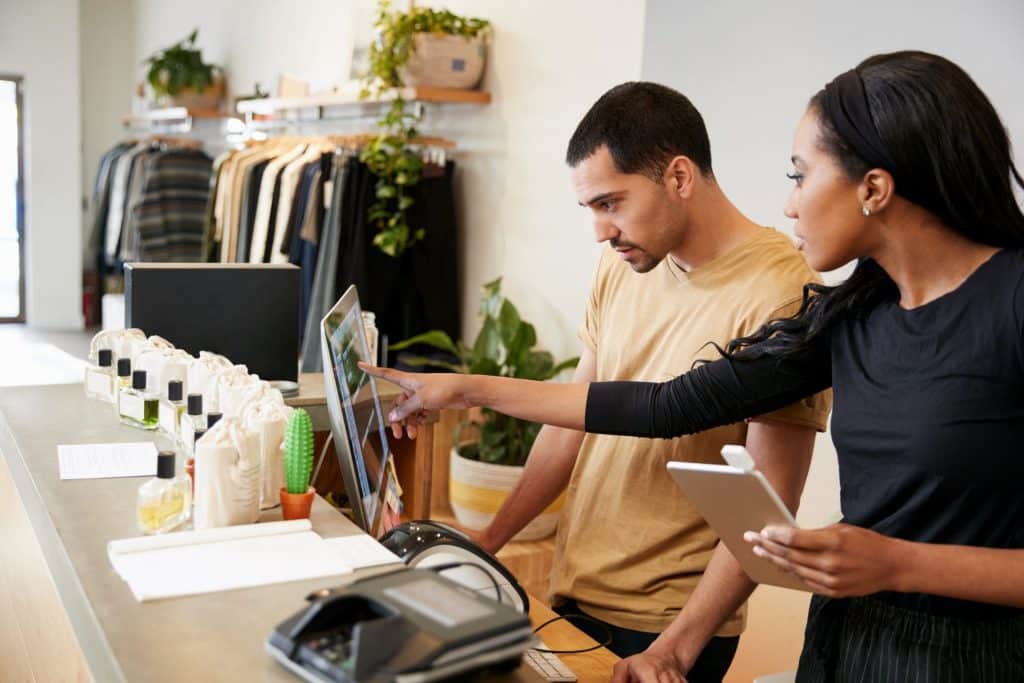The retail industry is alive and full of potential. In 2019, Walmart reported that the chain serves nearly 275 million customers every week. People are still visiting brick-and-mortar stores dedicatedly.
InMoment’s 2018 US Retail CX Trends Report revealed that 77% of consumers, among whom 60% of them were millennials, have successfully developed relationships with brands over a decade.

What is retail training?
Retail training introduces practices and behaviors that can lead to positive customer experiences and more sales to new employees. This can include:
- Being an expert in product knowledge
- Assisting customers politely but efficiently
- Maintaining a clean and enjoyable store environment
- Closing sales and upselling customers
Retail sales training teaches employees to engage with customers and build a relationship of trust. Being able to showcase a product and its advantage is a necessary skill for a retail employee. Employees learn how to relay as much information as possible and close transactions in a short amount of time.
According to Salesforce, 53% of millennials feel that store associates lack the tools required to provide good customer service. There is a lot of room for improvement.
Why is retail training important?
In this age of e-commerce, retail employees are the ones with the power to convert browsers into customers in a store. There is a growing need for knowledgeable and amiable retail employees who can engage customers. Well-trained employees can increase sales revenue and boost the popularity of the store.

Synchrony conducted a study to find that customers now desire experience-driven retail. The Retail Trends 2019 report found that 69% of consumers prefer live experiences to connect with the brand. Employees have to be trained to organize exciting events.
There are a few standard training categories to be included in every retail staff training manual:
- Retail Onboarding
- Safety
- Customer Service
- Product Knowledge
- Sales
In the absence of proper retail training, employees will be unable to capture the attention of buyers. A retail training plan provides guidance about what to do from the moment a buyer walks in the door until they leave.
Businesses that forego retail training miss out on higher conversion rates and increased customer satisfaction. Research by PwC found that 73% of all customers evaluate their store experience when making purchases. 32% of all customers also reported that they would avoid a brand after a negative experience even if they love it.
How to engage retail employees?
Retail employees might need some encouragement to get started with the training. Providing retail learning resources is not enough; sometimes, you need fun ways to train retail staff.
The following retail staff training ideas can inspire you:
- Scenario-based training:
Establishing a scenario and letting your employees act it out will add an element of fun. Instead of just reading the training manual, they will be able to apply the knowledge to their work. This is an easy way of demonstrating both the positives and negatives of a situation.

- Microlearning:
Onboarding and retail training can become easier with microlearning. Employees can consume smaller nuggets of knowledge faster, and they can also retain it better. They will have more time to process what they learn before moving on to the next topic.
- Gamification
Competitive salespeople often perform better when they learn through games. Quizzes and speaking exercises will fuel them to do better. With the introduction of advanced learning platforms, gamification on a larger scale is now possible.
Want to learn more? Let’s chat!
Types of retail training materials
The ideal retail training plan includes various online and offline tools to engage the learners and help in knowledge retention.
- Case studies
Case studies and real-life examples are easily comprehensible and more relatable to employees. They will be able to connect the retail training material with their workday occurrences. You can create an elaborate presentation with images and a narration; or, you can conduct a weekly storytelling session. - Videos
Visual retail training materials are impactful; hence videos are an excellent learning tool. You can encourage your employees to learn one concept at a time by watching the videos. With Bites, you can create a short training video or a bite covering a specific topic instantly. Once you make a complete module of bites, you can share the playlist with your employees. - Assessments
Evaluating the learners from time to time will encourage and motivate them. You can make quizzes to test them. Bites happens to be an effective learning platform because it comes with an analytics dashboard using which you can track employees’ progress and give them assignments. - Webinars
Online learning is highly accessible and allows the employees to continue the training process even when they are not working. Scheduling webinars is simple and cost-effective. - Roleplaying
Shadowing and roleplaying are excellent techniques of learning retail techniques. You can take an informal approach and present different scenarios to the employees. This will help them implement the knowledge they gain.
Retail coaching tips
If you want to improve your training programs for retail employees, you can follow these tips:
- Personality matters
When hiring new employees, you should learn more about their values and attitudes. The training program has its limitations. The learners must be polite and kind by nature; you can teach them the necessary skills through training. - Adjust your training programs
Different retail training methods work for different types of employees. Learn about your new hires individually so you can figure out their preferred learning methods. Adjust your training approach to get the best results. - Mix up different learning methods and tools
There is no need to stick to a singular training method. You can incorporate as many learning elements as you like into the training so that the employees experience well-rounded development.
- Regular roleplaying practices
If you want your staff to master retail training, you should introduce more roleplaying exercises so that employees have more opportunities to learn. Re-enacting conversations and creating sample scenarios can be helpful. Employees who do not want to participate in the roleplaying actively can observe. - Continuous improvement is the goal
Retail training continues even after the formal learning process is over. The retail industry is continuously evolving, and employees must remain up-to-date with the developments.
Training program for retail staff
A retail training plan should have some key elements.
- Customer journey map:
It traces the path of the customer from the moment they step into your store until they receive the delivery of their product. The map also includes follow-up services. - Onboarding materials:
Answering the top questions of new employees will help them get started. They will be excited to take on their new responsibilities with a clear idea of their expectations. - Product knowledge training:
Employees should know the complete suite of services and products offered by the company. They can compare and contrast products and make recommendations. Product knowledge is essential. - Behavioral plan:
Retail employees should know how to greet customers and develop an instant rapport. The goal is to sell the product based on its benefits. Being able to close the transaction is also a skill to develop. This also includes customer service training. - Technical knowledge:
Physical retail employs various interactive technologies to enhance the in-store experience. QR codes, imaging software, touch screens, virtual reality, augmented reality, facial recognition, automated checkouts and digital price tags are just some of the technical tools in a retail store. Accenture recently conducted a survey of retail industry executive decision-makers and consumers to find that consumers enjoy immersive technology. Integrating digital technology into the retail experience can greatly improve customer perception.
Summary
Training programs for retail employees are essential for companies to improve their performance. Helpful employees who know how to handle customers and close sales with a smile will boost your retail business tremendously. Retail training is a worthy investment.
With Bites, you can create short videos and compile them as retail training material. You can share the complete playlist with your employees so they can learn on their own. The analytics dashboard will let you track the learners’ progress.
The instant messaging feature will let you update employees instantly about new developments. On the one hand, you can use a customized Bite to show off your product to possible leads, and on the other hand, you can demonstrate retail techniques to employees.




